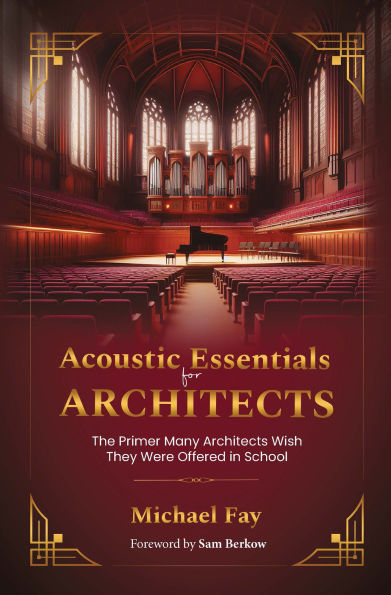Acoustics is a vital but often overlooked part of architecture. It is frequently misunderstood or not even offered in most architectural schools, so many architects do not receive the practical training necessary to maximize their designs. With this education gap in mind, Acoustic Essentials for Architects is the primer architects need to fill the void.
Written by an industry veteran with 45 years of hands-on experience in a low-tech, conversational style, it will help architects better understand and visualize the relationship between the physical shapes, textures, and dimensions of their work and how those design decisions impact the qualitative behavior of sound. This peer-reviewed book details the essential terminology and concepts of architectural acoustics, including why it's so important to understand the incredible dimensional range of wavelengths between the lowest and highest audible sounds, the feasibility aspects of applied acoustics, and the trade-offs to blending architecture, acoustics, and pragmatism. It also explains the importance of interior seating symmetry for medium and large rooms and optimizing for speech intelligibility. With the information provided, architects can improve their designs by shifting from unintentional acoustical results to those that achieve a planned outcome.
1146964417
Written by an industry veteran with 45 years of hands-on experience in a low-tech, conversational style, it will help architects better understand and visualize the relationship between the physical shapes, textures, and dimensions of their work and how those design decisions impact the qualitative behavior of sound. This peer-reviewed book details the essential terminology and concepts of architectural acoustics, including why it's so important to understand the incredible dimensional range of wavelengths between the lowest and highest audible sounds, the feasibility aspects of applied acoustics, and the trade-offs to blending architecture, acoustics, and pragmatism. It also explains the importance of interior seating symmetry for medium and large rooms and optimizing for speech intelligibility. With the information provided, architects can improve their designs by shifting from unintentional acoustical results to those that achieve a planned outcome.
Acoustic Essentials for Architects: The Primer Many Architects Wish They Were Offered in School
Acoustics is a vital but often overlooked part of architecture. It is frequently misunderstood or not even offered in most architectural schools, so many architects do not receive the practical training necessary to maximize their designs. With this education gap in mind, Acoustic Essentials for Architects is the primer architects need to fill the void.
Written by an industry veteran with 45 years of hands-on experience in a low-tech, conversational style, it will help architects better understand and visualize the relationship between the physical shapes, textures, and dimensions of their work and how those design decisions impact the qualitative behavior of sound. This peer-reviewed book details the essential terminology and concepts of architectural acoustics, including why it's so important to understand the incredible dimensional range of wavelengths between the lowest and highest audible sounds, the feasibility aspects of applied acoustics, and the trade-offs to blending architecture, acoustics, and pragmatism. It also explains the importance of interior seating symmetry for medium and large rooms and optimizing for speech intelligibility. With the information provided, architects can improve their designs by shifting from unintentional acoustical results to those that achieve a planned outcome.
Written by an industry veteran with 45 years of hands-on experience in a low-tech, conversational style, it will help architects better understand and visualize the relationship between the physical shapes, textures, and dimensions of their work and how those design decisions impact the qualitative behavior of sound. This peer-reviewed book details the essential terminology and concepts of architectural acoustics, including why it's so important to understand the incredible dimensional range of wavelengths between the lowest and highest audible sounds, the feasibility aspects of applied acoustics, and the trade-offs to blending architecture, acoustics, and pragmatism. It also explains the importance of interior seating symmetry for medium and large rooms and optimizing for speech intelligibility. With the information provided, architects can improve their designs by shifting from unintentional acoustical results to those that achieve a planned outcome.
49.95
In Stock
5
1

Acoustic Essentials for Architects: The Primer Many Architects Wish They Were Offered in School
220
Acoustic Essentials for Architects: The Primer Many Architects Wish They Were Offered in School
220Related collections and offers
49.95
In Stock

Product Details
| ISBN-13: | 9781604278668 |
|---|---|
| Publisher: | Ross, J. Publishing, Incorporated |
| Publication date: | 05/27/2025 |
| Sold by: | INDEPENDENT PUB GROUP - EPUB - EBKS |
| Format: | eBook |
| Pages: | 220 |
| File size: | 6 MB |
About the Author
From the B&N Reads Blog
